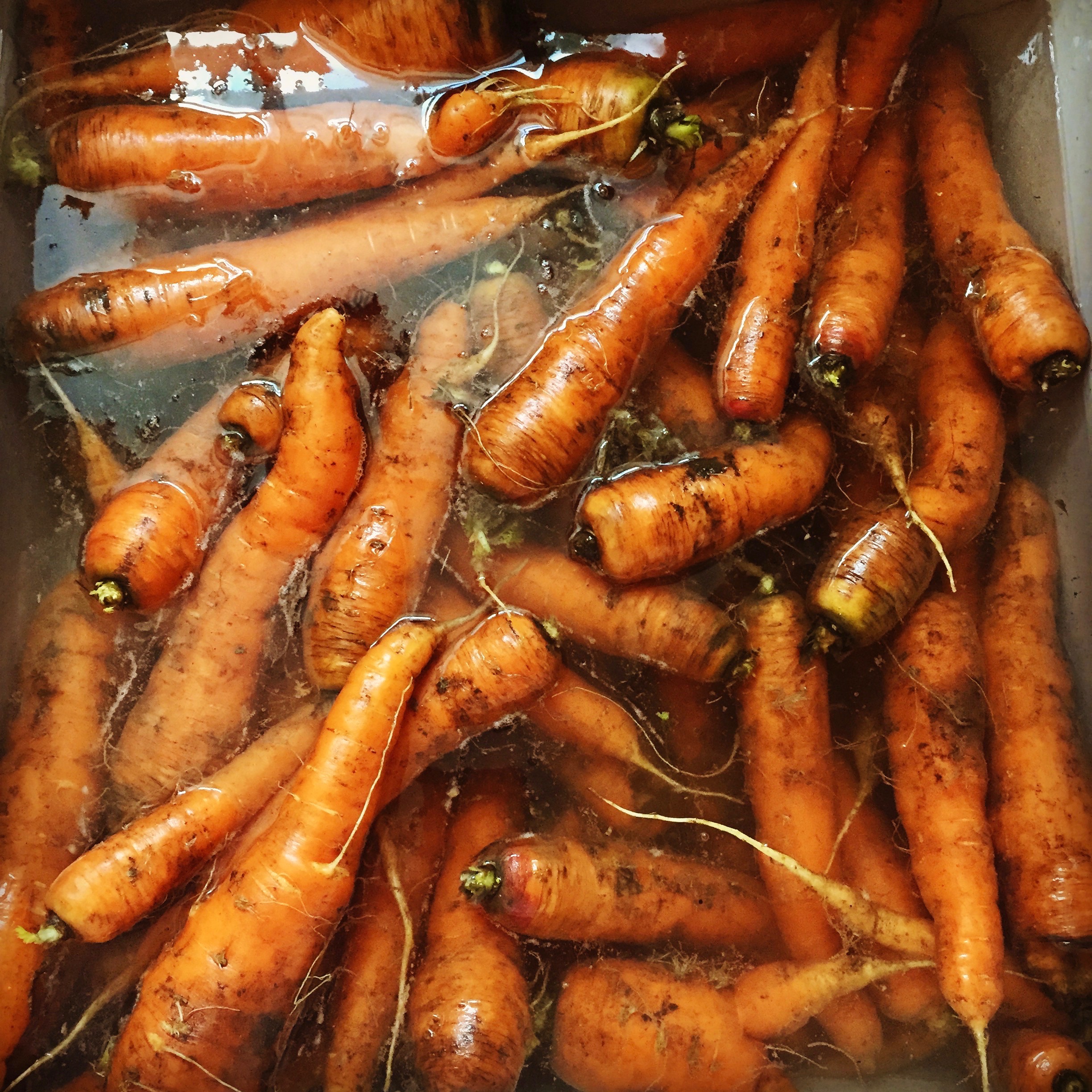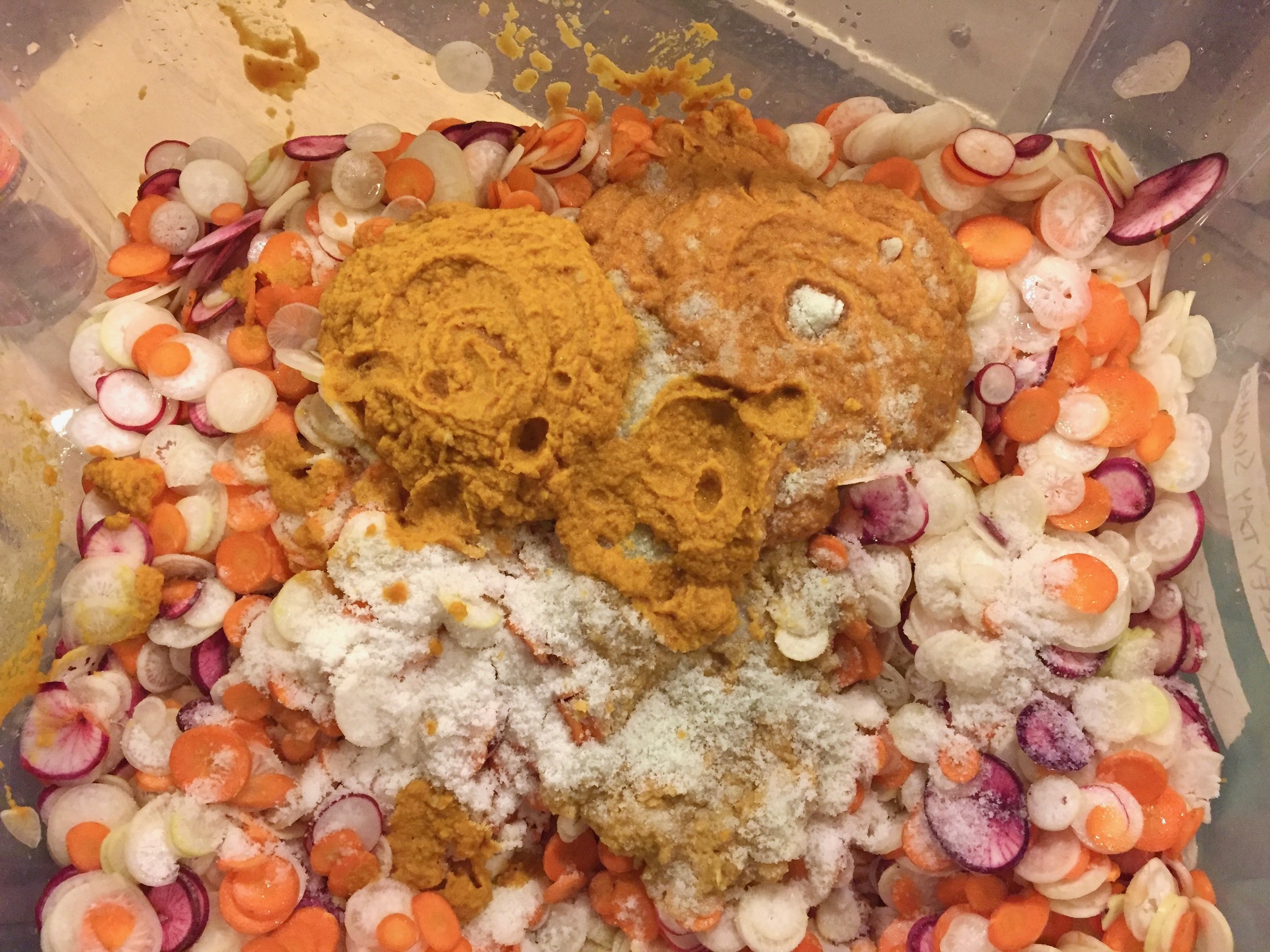Farm Pickles & Kimchi
I'll be honest with you, despite all of my years of professional and home cooking experience, I have done very little in the way of fermentation. Not sure if I was intimidated or just lazy, but it wasn't until a year or so ago, that I made my first batch of sauerkraut fermented on my very own kitchen counter. The key for me, was visiting some farmer friends who hooked me up with the easiest recipe ever: shred a head of cabbage, toss on a tablespoon or two of salt, massage with your hands, add any spices you like (such as mustard, caraway or hot pepper), pack tightly into glass canning jars, screw tops on (but not too tight), place on a sheet pan to catch liquid that will bubble out, and keep jars in a warm area. Let the jars sit there for 4 days to a week, unscrewing (but not removing) the lids to release any pressure once a day. When the taste is to your liking, transfer to the fridge to store and continue to cure for as long as you like. Eat daily for good health.
This super easy recipe is still my go-to basic recipe for sauerkraut, but the kimchi style pickles I tasted in farmer Steve's kitchen at Massaro Community Farm while recording the Winter on the Farm episode, were seriously delicious, crisp and complex with just the right amount of sour, salt, and zing of ginger and hot pepper to keep you munching.
shizue & jacquie’s fall kimchi
by Shizue Roche Adachi & Jacqueline Lewin Munno
Ingredients (by weight)
Mixed veggies (I prefer to use at least ½ hakurei turnips, and the rest in kohlrabi and carrots, napa cabbage can be used but not in great quantities)
Onion 4% (weight of mixed veggies)
Ginger 2%
Turmeric, fresh 2% (or 1% if dried)
Garlic 1.5%
Fermented chili paste 1% (depends on heat of paste, when mixed the kimchi should have heat but retain a sweetness) or hot peppers, seeded 1.5-2%
Salt (3% total veggie weight, or 4% if veggies are low in water content)
- Cut the cabbage lengthwise into quarters and core (if using). Slice each quarter crosswise to create 1” strips.
- Peel kohlrabi and halve or quarter each bulb depending on its size. Slice to ⅛-¼” thickness (a Cuisinart can be of use for this step).
- Top carrots and slice to ¼” thickness, halving the thicker end to make half circles (again, a Cusinart can be used).
- Mix all chopped vegetables together with 3% of their weight in salt in large bowl or tub.
- Peel your garlic. Chop roughly and add to your Cuisinart. Coarsely chop the onions and add to the garlic and ginger mixture. Measure in your chili paste or, if unavailable, the fresh chopped peppers. Puree the whole mixture until it forms a homogeneous paste. Taste and adjust as necessary.
- Add the paste to the vegetables and mix until all vegetables are well coated. The use of gloves is encouraged as hot peppers can irritate the hands.
- Let rest for 1 hour, allowing the salt to draw the moisture from the vegetables.
- After an hour, mix the slaw once more and pack tightly into a stoneware crock or a large mason jar. The juices from the kimchi should rise over your hands as you pack down the slaw. Make sure there are no air bubbles. Leave ample room (3” headspace on a jar) and weigh the kimchi down with a weight or a smaller jar filled with water. Rest a towel over the top and secure with some string or a rubber band. Keep in a cool, semi-dark environment.
- For the next seven days of the ferment, push down the weight daily to remove carbon dioxide bubbles. The crock will calm down as the bacteria begins to cease production of CO2 and only creates lactic acid. It will not smell amazing.
The kimchi will be ready when you think it tastes ready. I begin checking at 3 weeks. Farm Manager Jeremy Oldfield lets his go for 5 weeks while others end the fermentation period at 10 days. Once deemed “ready,” repack the kimchi into mason jars. Pack them down hard, making sure no air bubbles are left, and top with brine.
Store in the refrigerator and pack down after every serving to increase shelf life. Kimchi will keep for 10 months but it’s best consumed within six months.
Farmer Steve's wife Jacquie happens to work on another farm herself, the Yale Farm where she is Programs Manager at the Yale Sustainable Food Program. There is a good deal of straight off the farm cooking in a beautiful outdoor kitchen that happens there, and she generously shared this recipe packet filled with numerous types of pickle & preserve recipes.
The outdoor kitchen at the Yale Farm. This picture is from a special meal I cooked for Columbian Chef Jorge Rauch in the fall of 2016.








